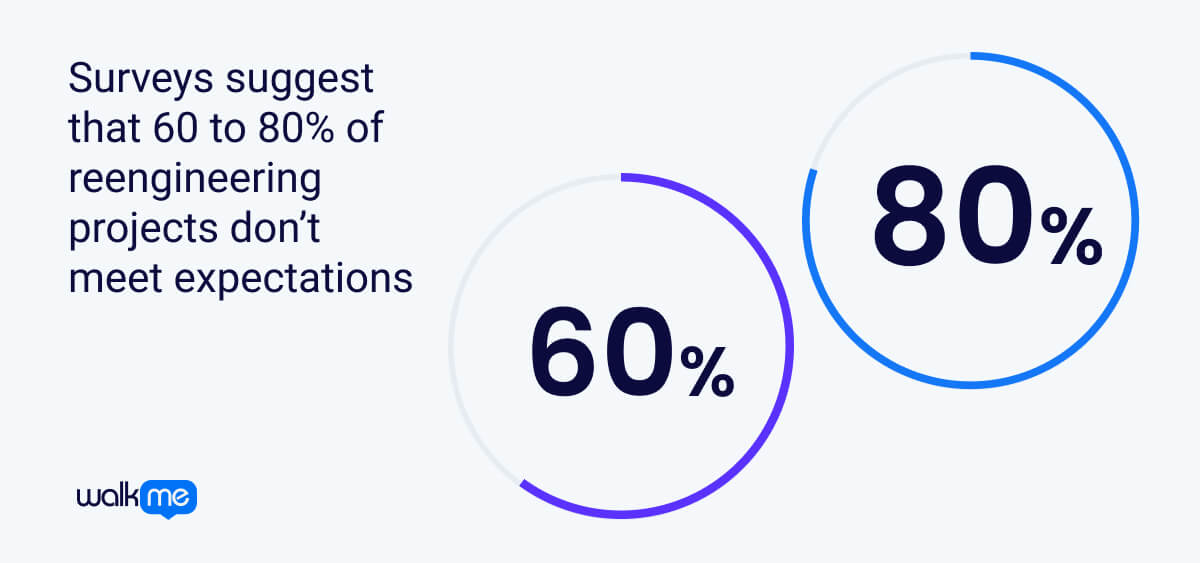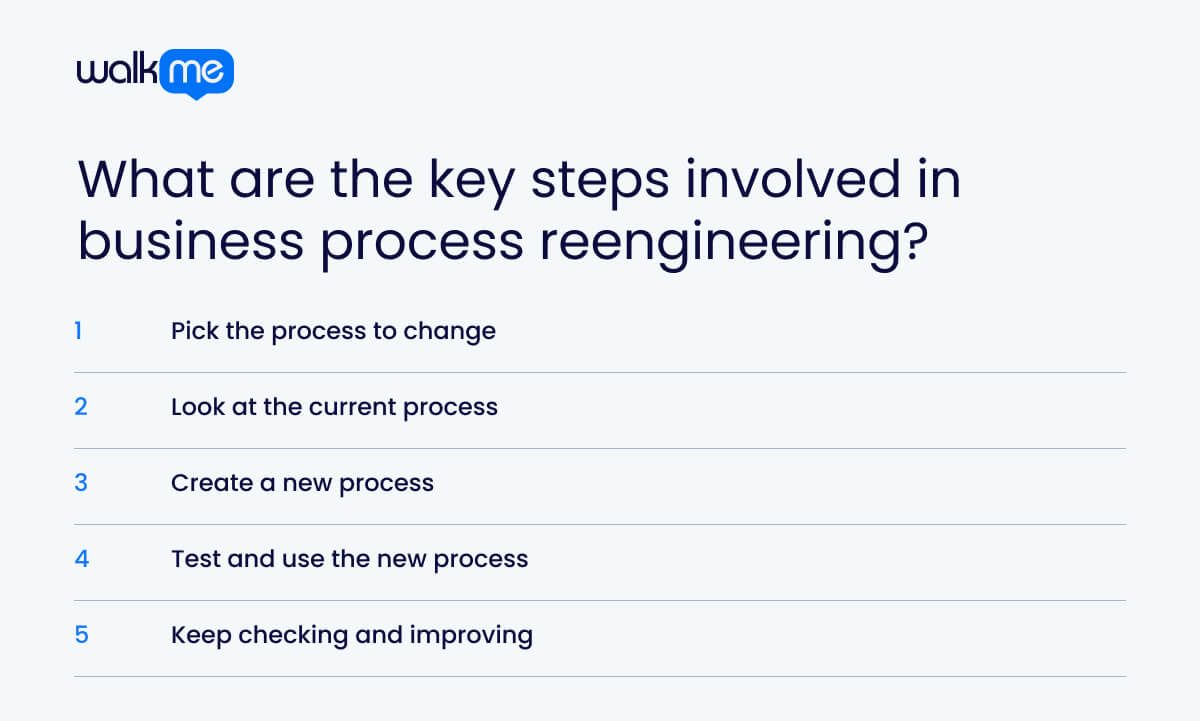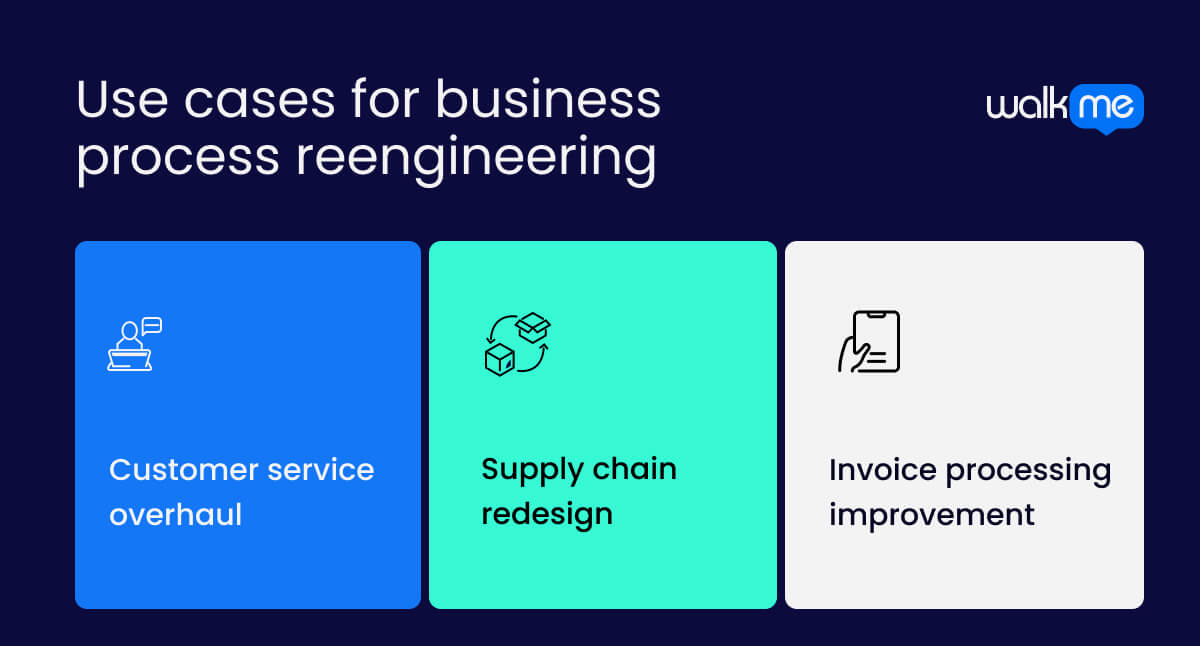What is business process reengineering?
Business process reengineering (BPR) is a way for companies to change their work processes dramatically. Instead of improving small parts, BPR examines the whole process and tries to find better methods. It often means eliminating unnecessary steps and using new tools or systems to make the work faster and easier.

The main idea of BPR is to focus on the entire process from start to finish, making sure it works well for the customer. This can mean changing how teams work together so that they can solve problems more quickly. The goal is to make the process faster, simpler, and better for everyone involved.
BPR has been important for many years. One study shows that 87% of companies surveyed were either participating in BPR projects or planning to take up such an endeavor in the next few years.

However, it can be easy for BPR projects to go wrong. Surveys suggest that 60 to 80% of reengineering projects don’t meet expectations. The top reason given is that people are reluctant to change how they work, especially if they are used to doing things a certain way.
If done right, BPR can save money, make customers happier, and help the company compete better.
What are the key steps involved in business process reengineering?

Understanding the key steps in business process reengineering helps ensure changes work well.
Each step is important for turning slow or messy processes into simpler ones that help the business, from examining how things are done now to developing and using better working methods.
Let’s go over the main steps of business process reengineering and see how they work together to improve results.
Pick the process to change
Start by choosing the most important process that needs fixing. It will usually affect how happy customers are or how smoothly things run.
Look at the current process
Study how the process works now. Check every step to see where things are slow or not working well.
Create a new process
After examining the old method, design a new process. The idea is to make things simpler and faster, sometimes using new tools or technology.
Test and use the new process
Try out the new process in a small way to see if it works. If it does, start using it across the company.
Keep checking and improving
After the new process is in place, observe how it works. If there are any problems, fix them, and keep finding ways to improve it.
BPR vs BPM vs BPI
Business process reengineering (BPR), business process management (BPM), and business process improvement (BPI) all try to improve business processes, but they do so in different ways.
- BPR makes big changes to completely fix processes
- BPM keeps track of and improves processes over time
- BPI makes small, gradual fixes to solve specific problems
Let’s look closer at how these three methods differ.
| Business process reengineering | Business process management | Business process improvement | |
| Definition | A method to completely change how a business process works to make it much better. | A way to manage and improve business processes over time, making sure they keep working well. | A strategy that involves making small changes to fix problems in the process without starting from scratch. |
| Focus | Making big changes to make processes faster and more efficient. | Managing and improving processes step by step over a long time. | Fixing small issues in existing processes to make them a little better. |
| Techniques | Process mapping (drawing how work is done), new technology, and new workflows to create better processes. | Uses tools to track how well processes are working and to make small improvements along the way. | Uses methods like identifying the main problem (root cause) or cutting waste (Lean) to improve specific parts of a process. |
| Goals | Make big improvements, like cutting costs in half or making services much faster. | Keep improving processes over time without big changes, making them run smoothly. | Make small changes that, over time, improve how well a process works. |
| Examples of use | A company changes its entire way of delivering products to make shipping twice as fast. | A business uses software to keep improving its customer service process. | A team fixes one step in a production line to reduce waste or make things faster. |
Use cases for business process reengineering

Business process reengineering can dramatically change different parts of a business. It can help improve customer service, the supply chain, and invoice handling.
To understand how BPR works, let’s look at three examples that show these changes in action.
Customer service overhaul
A company’s customer service might include answering calls, handling complaints, and processing returns. With business process reengineering, the company could create a new system that combines all these tasks into one easy-to-use platform. As a result, customer problems can be solved more quickly. It also makes the team’s job easier.
Supply chain redesign
A company’s supply chain might involve many suppliers, warehouses, and delivery steps. To redesign this process, the company could use a new system that tracks everything in real time. When the supply chain works better, it reduces delays and gets products to customers more quickly.
Invoice processing improvement
A company’s invoicing might involve lots of manual work, like creating, sending, and tracking invoices. With business process reengineering, the company could use an automated system to handle all these tasks. This system sends invoices automatically, tracks payments, and alerts the team about overdue bills. Invoicing becomes faster, and there are also fewer mistakes.
What are the advantages of business process reengineering?
Business process reengineering brings many benefits to companies. Businesses can make their processes faster, cheaper, and better by changing how work is done. Customers are happier, money is saved, and the company is kept ahead of its competitors.
Let’s look at the main advantages of using business process reengineering.
Improves efficiency
Business process reengineering makes work faster and smoother by changing tasks. The company can get more done with less effort and fewer resources. Over time, these changes lead to much better results and overall performance.
Reduces costs
By making processes more efficient, the company can spend less on unnecessary expenses, resulting in less waste and extra costs. In the long run, these changes help the company save a lot of money.
Enhances customer satisfaction
Better and faster service makes customers happier with their experience. When customers are satisfied, they are more likely to return and tell others about the company. A positive reputation can be built, which will attract more business.
Increases productivity
New processes help employees work better by removing extra steps and using new tools. Workers get more done in less time and with less effort, and the company becomes more productive and handles more work efficiently.
Speeds up operations
Reengineering processes helps eliminate delays and speed up work. This helps the company respond quickly to changes and meet new demands. Overall, the company can work more efficiently and deliver products or services faster.
Boosts quality
Redesigning processes means fewer mistakes and better results, leading to higher-quality products or services. When quality improves, customers are more satisfied and trust the company more. High standards and a strong reputation can therefore be maintained.
Encourages innovation
Reengineering often involves using new ideas and technology to find better ways to work. This helps the company think of creative solutions and explore new methods, allowing it to discover more effective and innovative ways to do business.
Strengthens competitive position
Improving processes helps the company stand out from its competitors by offering better services or products. The company benefits from more customers and an edge in the market, and a stronger competitive position supports the company’s growth and long-term success.
What are the challenges of business process reengineering?
Changing how processes work can bring big benefits, but it also comes with some problems.
Knowing these challenges is important to handle the changes well and make sure the benefits are worth the effort.
Resistance to change
People might not want to change how they work, making it hard to start new processes. Employees might feel unsure or uncomfortable with the changes. Getting everyone on board can take extra effort and clear communication.
High costs
Changing processes can be expensive, with costs for new technology, training, and help from experts. These costs can add up quickly and be a big burden, especially for smaller companies.
Implementation difficulties
Starting new processes can be complicated and may disrupt daily work. The changes might not go smoothly, causing delays or problems at first. Managing these issues needs careful planning and attention.
Need for new skills
Employees might need new training or skills to adjust to the new processes. This requires time and resources to teach everyone what they need to know. Ensuring everyone is trained can be a significant challenge during the change.
How can DAPs help with business process reengineering?
Digital adoption platforms (DAPs) can be very helpful when changing business processes. They make it easier for companies to use new methods and tools, and the platform provides support and guidance to help businesses improve their processes. Let’s see how DAPs can make business process changes better and more efficient.
Onboarding and training
Interactive lessons and guides are available to help users learn new processes smoothly. They provide step-by-step instructions and helpful tips that make learning the new system quick and easy. Employees can, therefore, get up to speed faster and reduce their need for lengthy training sessions.
User support
DAPs provide real-time help and advice directly within the new system. They can answer questions, solve problems, and offer suggestions as users work with the new processes. This feature allows users to adapt more quickly and minimizes disruptions during the change.
Process optimization
The platform can track how well new processes are working and spot areas where users might have trouble. They collect data on user performance and process efficiency to help identify what needs improvement. With this information, companies can make adjustments that improve how the processes function.
Change management
Change management is made easy, as DAPs guide users through new processes with clear instructions. They offer ongoing support to make the transition to new ways of working smoother and more manageable. Resistance to change becomes less of an issue; it makes adapting easier for everyone involved.forts on track. Regular tracking allows for quick changes to plans, improving results. It also encourages accountability, as teams can see how their work affects the project.